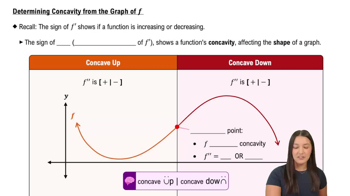Table of contents
- 0. Functions7h 52m
- Introduction to Functions16m
- Piecewise Functions10m
- Properties of Functions9m
- Common Functions1h 8m
- Transformations5m
- Combining Functions27m
- Exponent rules32m
- Exponential Functions28m
- Logarithmic Functions24m
- Properties of Logarithms34m
- Exponential & Logarithmic Equations35m
- Introduction to Trigonometric Functions38m
- Graphs of Trigonometric Functions44m
- Trigonometric Identities47m
- Inverse Trigonometric Functions48m
- 1. Limits and Continuity2h 2m
- 2. Intro to Derivatives1h 33m
- 3. Techniques of Differentiation3h 18m
- 4. Applications of Derivatives2h 38m
- 5. Graphical Applications of Derivatives6h 2m
- 6. Derivatives of Inverse, Exponential, & Logarithmic Functions2h 37m
- 7. Antiderivatives & Indefinite Integrals1h 26m
- 8. Definite Integrals4h 44m
- 9. Graphical Applications of Integrals2h 27m
- 10. Physics Applications of Integrals 2h 22m
5. Graphical Applications of Derivatives
Concavity
Problem 74
Textbook Question
Concavity Determine the intervals on which the following functions are concave up or concave down. Identify any inflection points.
h(t) = 2 + cos 2t on [0,π]
 Verified step by step guidance
Verified step by step guidance1
To determine the concavity of the function h(t) = 2 + cos(2t), we first need to find its second derivative. Start by finding the first derivative h'(t). The derivative of cos(2t) is -2sin(2t) using the chain rule.
Next, find the second derivative h''(t). Differentiate h'(t) = -2sin(2t) to get h''(t) = -4cos(2t) using the chain rule again.
To find intervals of concavity, set the second derivative equal to zero and solve for t: -4cos(2t) = 0. This simplifies to cos(2t) = 0. Solve for t in the interval [0, π].
The solutions to cos(2t) = 0 are t = π/4 and t = 3π/4 within the interval [0, π]. These are potential inflection points where the concavity might change.
Test the intervals (0, π/4), (π/4, 3π/4), and (3π/4, π) by choosing test points in each interval and evaluating the sign of h''(t). If h''(t) > 0, the function is concave up; if h''(t) < 0, the function is concave down. Identify the intervals of concavity and any inflection points based on these tests.
 Verified video answer for a similar problem:
Verified video answer for a similar problem:This video solution was recommended by our tutors as helpful for the problem above
Video duration:
6mPlay a video:
Was this helpful?
Key Concepts
Here are the essential concepts you must grasp in order to answer the question correctly.
Concavity
Concavity refers to the direction in which a function curves. A function is concave up on an interval if its second derivative is positive, indicating that the slope of the tangent line is increasing. Conversely, it is concave down if the second derivative is negative, meaning the slope is decreasing. Understanding concavity helps in analyzing the behavior of functions and identifying points of inflection.
Recommended video:

Determining Concavity Given a Function
Second Derivative Test
The second derivative test is a method used to determine the concavity of a function. By calculating the second derivative of a function, we can assess whether it is positive or negative over specific intervals. If the second derivative changes sign, it indicates a point of inflection, where the function changes from concave up to concave down or vice versa. This test is essential for identifying concavity and inflection points.
Recommended video:

The Second Derivative Test: Finding Local Extrema
Inflection Points
Inflection points are points on a curve where the concavity changes. At these points, the second derivative of the function is either zero or undefined. Identifying inflection points is crucial for understanding the overall shape of the graph and how it behaves as it transitions between concave up and concave down. These points can provide valuable insights into the function's behavior and are often of interest in optimization problems.
Recommended video:

Critical Points

 6:38m
6:38mWatch next
Master Determining Concavity from the Graph of f with a bite sized video explanation from Callie
Start learningRelated Videos
Related Practice






